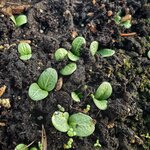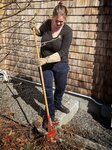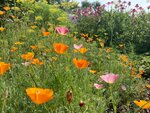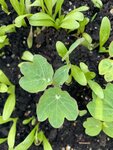






The North Shore has much going on in the way of gardening—from flower farming and amazing CSAs to spectacular home and formal gardens. But out on Southern Avenue in Essex, just next to the Cox Reservation, is a gardener who is trying to do something rather unique with five acres of sleepy land.
For Sophia Johansson, the land is a personal work space: growing hard-to-find flower varieties for my floral accounts, building out nursery stock for clients and fellow gardeners, finessing growing techniques for edible flowers and building a “chef’s garden.”
Johanson came to gardening while studying in the Berkshires in her early 20s. She felt alive academically but otherwise restless and closed in. She discovered that being out of doors was the solution for this and in short order managed to manifest an apprenticeship with the primary gardener at a property regularly featured in Martha Stewart Living and whose owner now writes a gardening column for the New York Times.
And so it began, Sophia dove in— foraging, wildcrafting and studying herbalism to further expand her knowledge of the natural world and all it had to offer. She acquired a second apprenticeship with the primary gardener and designer at Campo di Fiori out of Sheffield, Massachusetts, and worked with Jenna O'Brien, who owns Viridissima Horticulture & Design. From there, she went on to study with a variety of farmers and plant folk in the Southwest and across the West Coast, working with the amazing producers that supply chefs like Alice Waters and spent time with vegan raw food artists and chefs.
Sophia found that the people she was spending time with just felt good to be around; they had a healthy relationship to their work, the earth, and their community.
There was a refreshing authenticity to it all —a balance; she liked it.
Now years later, having spent countless hours in the dirt, Sophia finds herself here, on the North Shore, living in Manchester and with a unique opportunity to take all that she has learned and use it to restore and rejuvenate a five-acre property—and we get to watch it happen. Sophia has deemed the property a demonstration garden; sharing her experience and her process with anyone who wants to learn.
What you will find are examples of many interesting methods, but primarily permaculture gardening and biodynamic farming.
Perhaps you are thinking, what exactly is permaculture gardening? According to Modern Farmer the term was coined by Bill Mollison, the Tasmanian son of a fisherman, in 1978. He defined it as, “the conscious design and maintenance of agriculturally productive systems which have the diversity, stability, and resilience of natural ecosystems. It is the harmonious integration of the landscape with people providing their food, energy, shelter and other material and non-material needs in a sustainable way.”
For her work Sophia explains, “In the context of this demonstration garden, and for any of the clients I work with, I am approaching their space and the land in a way that looks at what are the resources currently available and how can we realize the resources that are already present either in the immediate vicinity, or in kind of the community to increase life to increase botanical life and encourage all of the ecosystem to work together to build a garden. In the context of the demonstration garden, it’s about figuring out what the land needs to improve soil, and what resources are available that we can leverage, it’s about introducing healthy, micro biota and microorganisms into the soil and into any amending that we’re doing.”
Similar to permaculture is the idea of regenerative agriculture and biodynamic farming. These gardening and farming practices center on the idea that we need to restore the soil that grows our food, plants, and flowers.
We tend to think more than ever about whether or not our plants and food is organic, which is awesome. However, we tend to think less about how the soil that produced that fantastic organic food was treated. Industrial farming methods tend to over-till, over-fertilize and overuse soil, growing the same crops on it again and again. All of this leads to a kind of soil death. The soil left behind is void of valuable microbes, that are essential for binding the soil and allowing for more oxygen, water, and essential minerals. This lifeless soil is also rendered unable to efficiently hold carbon, releasing it into the atmosphere and contributing to global warming.
It’s a mix for Sophia, she explains, “I guess it’s hard for me to pinpoint how exactly what I am doing dovetails with permaculture principles and biodynamics because we’re still starting from scratch. I think that the unique thing that’s really significant about starting from scratch using a permaculture lens and utilizing a biodynamics process would be to just say how do we improve where we are in a way that protects the Earth.”
“Gardeners are really fond of saying things like right plant, right place and I think that it’s a good way to capture how if we match the right plants to the right growing conditions, the plants just grow beautifully and here in the context of this acreage in Essex, as well as in any of the gardens that I’m working in I’m always asking myself: ‘How do we take the strengths and the unique specialty components of the space in front of us and leverage those to increase botanical life?’,” she continued. “For example, there is one garden that I am restoring, that lay fallow for quite a bit, but now is active and we are really trying to protect all of the unique and rare plants that grow on the site, namely, the native lady slipper. And in terms of biodynamics, I’m going to be testing the soil I’m going to be utilizing garden amendments, and I’m going to be adding preparation’s that Rudolf Steiner (1861-1925, the founder of the biodynamic approach to agriculture) developed and taking a whole systems approach to planting.”
Balance. Once Sophia has restored the land, her goal is to cultivate seeds and plants capable of withstanding the challenges of our somewhat inhospitable North Shore soil. Then to use these seeds to grow flowers for clients and plants to sell and work with. She also plans to create specialty soils that inoculate with biodynamic preparations. All the while continuing with her current clients to rewild their lawns, manage their greenhouses, and support their gardens in a healthy and environmental way.
Ultimately, she said, thegoal is to expand the business’ product offerings so that Cape Ann Gardens is less dependent on consuming flowers, plants, and amendments produced further than 30 miles from home.
As for the five acres in Essex, it is the beginning of learning to do things differently. It’s about returning to the way of things used to be — balanced.
And I suspect, like the folks Sophia spent time with at the beginning of her journey, it will feel very good to be around.